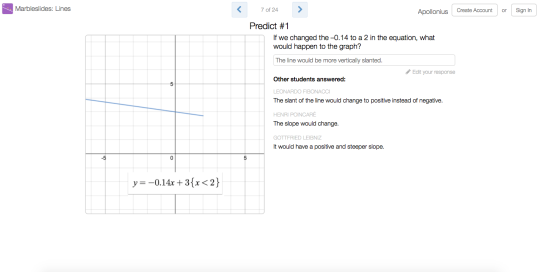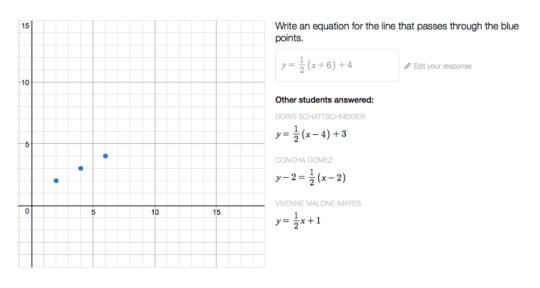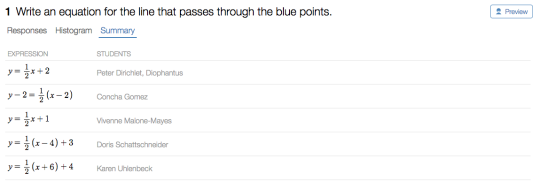When authoring a Desmos activity there is an option for answers to be
submitted to the teacher, or submitted to the class. We asked the Desmos
fellows this week whether or not they find it beneficial to let students see
their classmates’ responses in a Desmos Activity, and how they might
make use of the responses during instruction. Our consensus was that it
depends on the type of problem and activity, and that seeing classmates’
response can serve many different purposes. Here are some of our ideas:
Nick Corley has noticed that when students are developing understanding of a new idea, seeing other responses can make students rethink their initial response as they work towards a full understanding of the concept. For example, in Marbleslides: Lines Apollonius may make the connection that vertically slanted means the same thing as slope, and that lines can have a positive or negative slope.

Teachers might choose to display some of these responses during a class discussion to help students make connections between their previous conceptions and the more formal presentation of a topic that they may encounter in a textbook. Suzanne von Oy appreciates this option for screens where students are asked to reflect on their strategy or explain thinking. Hearing how classmates word ideas can help with the learning process.
Kendra Lockman and Paul Jorgens both shared that feedback from classmates during the initial part of a practice activity can help students build confidence. Paul offered that if there is a single correct answer to a set of screens, it might be helpful to start with “Submit to Class” so students can self correct or self affirm and end with a “Submit to Teacher” problem to serve as an exit ticket.

The responses in this activity offer students a chance to check their thinking, but to also see several ways to represent the correct answer. Scott Miller appreciates opportunities like this for students to identify equivalence and differences in words, equations, thinking and graphs.
Another way to let students see classmates’ responses is to display the teacher dashboard. The summary view can be used to highlight different ways to represent answers, and can serve as a conversation starter around developing conceptions.

In her role as a math coach, Jenn Vadnais supported teachers in using both the dashboard and “Submit to Class” option to create opportunities for math discourse that supports student learning. She shared that students love reading their classmates’ responses.
Heather Bolur has also found that her students enjoy reading responses from their classmates, and that using “Submit to Class” keeps them from answering with “I don’t know”.
Allison Krasnow has found “Submit to Class” to be a distractor for the 4th and 5th grade students that she works with. She’s found it more valuable to pause the activity and pull the class to the rug to look carefully at a few responses.
What are other examples where you’ve found it beneficial to let students see their classmates’ responses? Let us know on Twitter @desmos.
